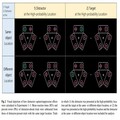Abstract
The present study investigated the effect of object representation on attentional priority regarding distractor inhibition and target search processes while the statistical regularities of singleton distractor location were biased. A color singleton distrac- tor appeared more frequently at one of six stimulus locations, called the ‘high-probability location,’ to induce location-based suppression. Critically, three objects were presented, each of which paired two adjacent stimuli in a target display by adding background contours (Experiment 1) or using perceptual grouping (Experiments 2 and 3). The results revealed that attention capture by singleton distractors was hardly modulated by objects. In contrast, target selection was impeded at the location in the object containing the high-probability location compared to an equidistant location in a different object. This object- based suppression in target selection was evident when object-related features were parts of task-relevant features. These findings suggest that task-irrelevant objects modulate attentional suppression. Moreover, different features are engaged in determining attentional priority for distractor inhibition and target search processes.
